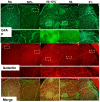Oxygen-Induced Retinopathy from Recurrent Intermittent Hypoxia Is Not Dependent on Resolution with Room Air or Oxygen, in Neonatal Rats
- PMID: 29724000
- PMCID: PMC5983662
- DOI: 10.3390/ijms19051337
Oxygen-Induced Retinopathy from Recurrent Intermittent Hypoxia Is Not Dependent on Resolution with Room Air or Oxygen, in Neonatal Rats
Abstract
Preterm infants often experience intermittent hypoxia (IH) with resolution in room air (RA) or hyperoxia (Hx) between events. Hypoxia is a major inducer of vascular endothelial growth factor, which plays a key role in normal and aberrant retinal angiogenesis. This study tested the hypothesis that neonatal IH which resolved with RA is less injurious to the immature retina than IH resolved by Hx between events. Newborn rats were exposed to: (1) Hx (50% O₂) with brief hypoxia (12% O₂); (2) RA with 12% O₂; (3) Hx with RA; (4) Hx only; or (5) RA only, from P0 to P14. Pups were examined at P14 or placed in RA until P21. Retinal vascular and astrocyte integrity; retinal layer thickness; ocular and systemic biomarkers of angiogenesis; and somatic growth were determined at P14 and P21. All IH paradigms resulted in significant retinal vascular defects, disturbances in retinal astrocyte template, retinal thickening, and photoreceptor damage concurrent with elevations in angiogenesis biomarkers. These data suggest that the susceptibility of the immature retina to changes in oxygen render no differences in the outcomes between RA or O₂ resolution. Interventions and initiatives to curtail O₂ variations should remain a high priority to prevent severe retinopathy.
Keywords: angiogenesis; astrocytes; insulin-like growth factor-I; intermittent hypoxia; oxygen-induced retinopathy; retina; vascular endothelial growth factor.
Conflict of interest statement
The authors declare no conflicts of interest.
Figures









References
-
- Rothschild M.I., Russ R., Brennan K.A., Williams C.J., Berrones D., Patel B., Martinez-Castellanos M.A., Fernandes A., Hubbard G.B., 3rd, Chan R.V.P., et al. The Economic Model of Retinopathy of Prematurity (EcROP) Screening and Treatment: Mexico and the United States. Am. J. Ophthalmol. 2016;168:110–121. doi: 10.1016/j.ajo.2016.04.014. - DOI - PubMed
MeSH terms
Substances
Grants and funding
LinkOut - more resources
Full Text Sources
Other Literature Sources
Research Materials

